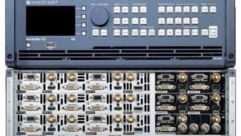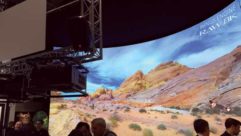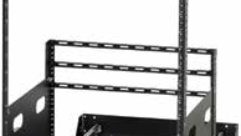
Front Projector Buyers’ Guide
Nov 1, 2007 12:00 PM,
By Jeff Sauer
A comprehensive overview of the 2007 models.
Charts

Christie Digital Mirage HD8
Like every week in Garrison Keillor’s fictional Lake Wobegon, it seems like it’s been a quiet year in the front-projection industry. Our annual chart of industry products lists more models than ever before, but there have been very few major industry announcements, and the products listed represent fairly subtle changes in market share. On the other hand, our chart this year does solidify the trend toward native wide resolutions and motion video-oriented projection.
We gathered information on 452 projectors for 2007, ranging in size from the smallest, 1lb., LED-lit “pico portables’ from Boxlight and Mitsubishi all the way up to Christie Digital’s behemoth more-than-500lb. digital-cinema projectors. The resolutions range from a small number of consumer-oriented 480p video projectors up to, again this year, Sony’s 4K-resolution SXRD digital-cinema projectors. As was the case last year, nearly one-third (149) of all the models we list are native widescreen.
By the numbers, the market share of Texas Instruments’ DLP has increased from 55 percent of the models in our list last year to 61 pecent this year. Interestingly, that gain is at the expense of both 3LCD technology and the various flavors of LCoS. One hundred and sixty-two, or 35.8 percent, of this year’s models are LCD-based, down from 39 percent. There are more DLP than LCD models in each size, except the 15lb.-to -30lb. class, where we list 55 LCD units and 40 DLP. And there are only 14 LCoS projectors, down to 3 percent of our total. Of course, the majority of the LCoS units that remain from JVC and Sony are critically acclaimed products that aren’t likely to go away. Canon’s LCoS units are more mainstream, portable-class products, and therefore face greater competition, but they produce strong images. The decrease in LCoS comes from the loss of OEM manufacturers using the fledgling technology.
UNDERSTANDING THE CHARTS
Last year we changed the organization of our chart from listing projectors strictly by weight class to grouping them by resolution within each weight class. The chart is organized the same this year, and it affords a greater overview of projectors by market and targeted use. Weight itself, while still an important factor for many purchases, is no longer the easy descriptor it once was. Legacy size categories like “microportable,” “ultra-portable,” and “portable” have become decreasingly apropos. Almost all front projectors have become more diminutive and, for example, 6lb.-to-8lb. “ultra-portables” today are just as likely to be stay-put classroom or conference-room projectors. The differences in resolution, on the other hand, tend to highlight both whether a given projector is aimed at motion-video or business-display use, and illustrate the trend toward native widescreen resolutions for both business and entertainment uses.
Naturally, the scope of a chart this large must be limited to basic specifications that often don’t offer much insight into each individual projector. We have used abbreviation codes for lens configuration and have called out digital ports (including DVI, HDMI, and SDI) and analog component connectivity by noting whether a given projector uses dedicated BNC or RCA for component or requires a converter cable to the 15-pin RGB port.
480P (WIDE-VGA, 854×480)
There are just four Wide-VGA models in the chart this year and all are family-oriented, living-room projectors. Three out of the four include built-in DVD drives and loudspeakers, and they are intended to be the centerpiece of an in-home family night at the movies. When playing a DVD, these projectors require no cable connections beyond the power cord. They are therefore very easy to use and can offer a bigger-screen movie experience than most consumers would be able to afford in a flatpanel.
Interestingly, the four 480p are all different weight classes, ranging in size from BenQ’s 6lb. W100 with no DVD player up to Epson’s 15lb. MovieMate 50, complete an 8W Dolby sound system for an all-in-one movie player. These four projectors are secondarily billed as potential large-screen gaming displays; however, the 480p resolution is minimalist for that use. Indeed, within the next year or two, 480p is likely to go the way of VGA business projectors, of which there are none in this year’s list, now that 720p chips and panels represent a “value” proposition compared to the emerging 1080p norm.
SVGA (800×600)
SVGA is the “value” resolution when it comes to business projectors, with several models now available for less than $600 from BenQ, Dell, Epson, InFocus, and ViewSonic. These units are bare-bones models with minimal connectivity, few features, often modest scaling and video processing, and fair color accuracy. But they do the job of putting presentation slides on a screen quite handily, and that alone is enough for SVGA to continue to represent 6.1 percent of the products in our list, just as they did last year. One might expect higher-resolution XGA to soon be relegated to this “value” category as higher (like SXGA+) and wider-resolution imaging devices become more affordable. However, those changes take time and SVGA’s “value” continues to bring new consumers — such as schools, small business, small houses of worship, etc. — into the front-projection market.
The most intriguing SVGA projectors, novelty or not, are the tiny 1lb. Pocket Projector and Bumblebee from Mitsubishi and Boxlight, respectively. These LED-lit models have very modest light output — although that has essentially doubled since they were first introduced more than two years ago, and they are expected to continue to get brighter. If so, these palm-sized projectors have the potential to offer front-projection technology completely new business opportunities, possibly including in-dashboard auto displays, point-of-sale 3D design, personal portable gaming, and more.
1024×576
There are just two wide 1024×576 models on our list. Neither is new, and that’s not surprising. This resolution marked an early move to widescreen DLP imaging devices, but it has little to offer and little future now that higher-resolution 720p chips are becoming affordable.
XGA (1024×768)
Nearly half (48.5 percent) of all the projectors listed in our chart are native-XGA resolution, and that’s no surprise given that the front-projector industry has always been driven largely by the needs of business users. Many business professionals carry a native XGA laptop computer and treat a travel projector as a computer peripheral or plug into a tabletop projector at conferences and panel discussions. Indeed, there’s little incentive for that broad group of users to pay more for higher resolutions.
On the other hand, there are just 15 XGA models that weigh more than 30lbs. and only eight of those are heavier than 50lbs. None weigh more than 82lbs. Those statistics speak directly to those portable and tabletop presentation uses, but also to the fact that larger projection screens need, and can now get, more pixels. Larger conference auditoriums and houses of worship, even those showing presentation slides, increasingly favor higher 4:3 resolutions such as 1400×1050 and, more often, wide resolutions. In fact, there are now eight SXGA+ models in the sub-6.6lb.class, twice as many as last year. That’s not a trend yet, but it might hint at one that’s coming.
XGA is the only resolution class listed in our chart in which there are more 3LCD projectors than DLP models. There are still more DLP units (58 compared to 37) below 6.6lbs., but above that 3LCD dominates the resolution class 85-42 over DLP. The reasons for that aren’t complex. LCD is a proven technology that most companies have been using for years; it offers potentially very good quality without OEM modifications to the basic technology, and it’s usually more affordable. When you take away DLP’s inherent size advantage, 3LCD does well, particularly as a mainstream solution.
720P (1280×720)
The number of native 720p in our chart has dropped significantly in the last year, both in raw number of units (46 down to 34) and in percentage of the overall market (12.8 percent down to 7.5 percent). It’s the result of the trend toward 1080p, which has become a display buzzword for quality. While it is hard to disagree vigorously with having more pixels to display an image, this drop is still surprising. After all, SVGA has been hanging around for years now based strictly on “value,” and 720p could and should be able to offer the same proposition to new potential home theater buyers of more modest means. Indeed, while Optoma does not list an MSRP for its HD73 on our chart, it is a native 720p, widescreen home theater projector for less than $1,000.
Ultimately, that probably puts the future of 720p into a market that’s been slow to get off the ground: lower-end consumer front projection. Past and present 480p products have tried to entice consumers with a big-screen experience without overwhelming success, due primarily to the extraneous hassles of cabling, screens, and positioning posed by front projection. However, companies such as Epson continue to experiment with bundles that include screens, built-in loudspeaker systems, and other ease-of-use features in hopes of finding a winning formula. Perhaps the higher relative quality of 720p compared to 480p will help.
WIDE-XGA (A VARIETY OF SPECIFIC PIXEL RATIOS)
Wide-XGA resolution projectors represent about 5 percent of the models on our list, and that’s up more than a point from last year. That’s not a dramatic change, but it does suggest that the early use of Wide-XGA (1024×768) for home theater, which has clearly yielded to video-centric resolutions of 720p and 1080p, has been superceded. Today’s Wide-XGA models are more often targeted toward business uses where widescreen laptops and desktop monitors are slowly reaching a critical mass. While small now, this may be one of the more interesting categories moving forward.
SXGA (1280×1024), SXGA+ (1400×1050), AND UXGA (1600×1200)
This entire collection of resolution categories is flat. There is only one SXGA model in our chart this year (Mitsubishi’s WD2000) and just two UXGA models. There are more SVGA+ models than last year, but the percentage of the market has dropped by more than a point. The exception is that there are now twice as many sub-6.6lb. SXGA+ units than last year.
1080P (1920×1080) AND WIDE-XGA (2048×1024)
As with last year, the growth is in 1080p rather than any of the higher-resolution 4:3 formats or even Wide-XGA. This year 14.8 percent of the projectors in our chart have a native 1080p resolution compared to 9.4 percent last year, and that represented a massive increase from the year before. As previously mentioned, 1080p is a buzzword for quality in video displays, and therefore it’s no surprise that manufacturers are taking advantage of it — and they’re doing it across almost the entire spectrum of weight classes. While there are no sub-6.6lb. 1080p models yet, there are several in all other classes — from Digital Projection’s 7.5lb., single-chip DLP models all the way up to high-end 3-chip models for both business and home theater.
The larger majority of 1080p products are DLP (51 of 67) and 20 of those are 3-chip solutions. Not surprisingly given its higher-resolution pedigree, 1080p is the resolution where there are the most LCoS units, but even so, there are just seven.
4K (4096×2160)
While this category hasn’t changed at all in the last year, still including Sony’s four models, that is likely to change with the InfoComm introduction of JVC’s new “4K2K” D-ILA chipset. While D-ILA is a variation of LCoS just as Sony’s SXRD is, JVC’s chips will be 20-percent smaller in diagonal size, and they should therefore yield both smaller and potentially more affordable 4K-resolution projectors.









